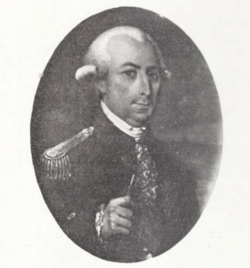Charles de Charritte facts for kids
Quick facts for kids
Charles de Charritte
|
|
|---|---|
 |
|
| Born | 1 November 1733 Pau, France |
| Died | 20 October 1815 (aged 81) |
| Allegiance | |
| Service/ |
|
| Years of service | 1749–1814 |
| Rank | Vice-admiral |
| Battles/wars | |
| Awards | |
Charles de Charritte (born in Pau, France, on 1 November 1733 – died in Rennes, France, on 20 October 1815) was an important officer in the French Navy. He served his country during major conflicts like the American Revolutionary War. He rose through the ranks to become a Vice-admiral, a very high position in the navy.
Contents
Charles de Charritte came from a well-known family in Pau. His father was a president in the local government. Charles decided to join the French Navy when he was just 16 years old, on 11 October 1749.
He started as a Garde-Marine, which was a bit like a naval cadet. He worked hard and was promoted to Lieutenant on 1 May 1763. This meant he was now an officer in charge of a small group of sailors.
Becoming a Captain
On 14 April 1777, Charles de Charritte was promoted again, this time to Captain. By this point, he had already gained a lot of experience at sea. Records show he had been on 17 different voyages and had commanded ships twice. He had also taken part in one battle.
Service in Major Wars
Charritte played a role in two big wars: the Seven Years' War and the American Revolutionary War. These wars involved many countries and were fought on land and at sea.
Command of the Auguste
In 1779, Captain Charritte was given command of a powerful warship called the Auguste. This ship had 80 cannons! He served as the main captain for a senior officer named Rochechouart. The Auguste was part of a large French fleet led by Admiral Orvilliers.
The Bourgogne and Key Battles
In 1781, Charritte commanded another important ship, the Bourgogne, which had 74 cannons. He was part of the fleet led by the famous Admiral De Grasse.
He took part in two very important naval battles during the American Revolutionary War:
- The Battle of the Chesapeake on 5 September 1781. This battle was crucial because it helped the American and French forces win the war.
- The Battle of the Saintes.
After these battles, Charritte was honored for his bravery. The people of Burgundy, who had helped pay for the Bourgogne, gave him a special sword. This was to thank him for saving their ship during the fighting.
Later Career and Retirement
In 1783, Charritte took on a different role. He became the general director of the harbor of Rochefort. This meant he was in charge of managing the port and its activities.
Rising to Admiral
He continued to advance in the navy. On 1 November 1786, he was promoted to Chef d'Escadre. This rank is similar to a Rear Admiral. He was given command of the 9th Squadron. In 1786, he sailed with a special training fleet, using the frigate Junon as his main ship. He became a Contre-amiral (another admiral rank) on 1 January 1792.
During the French Revolution
When the French Revolution began, Charritte decided to step away from public life. He moved to a quiet area called Touraine. Even though he tried to stay out of politics, the French government asked him to join a special naval council in Paris in 1799.
Final Honors
After the French monarchy was restored, Charritte received his highest honors. On 6 July 1814, he was given the Grand Cross of the Order of Saint Louis, a very prestigious award. He was also promoted to the rank of Vice-admiral, the second-highest rank in the French Navy.

